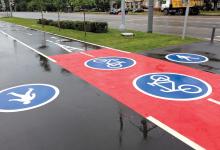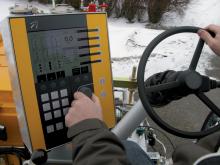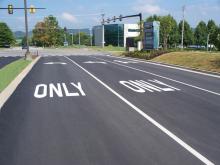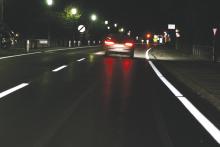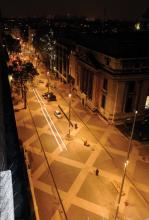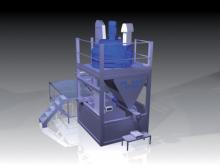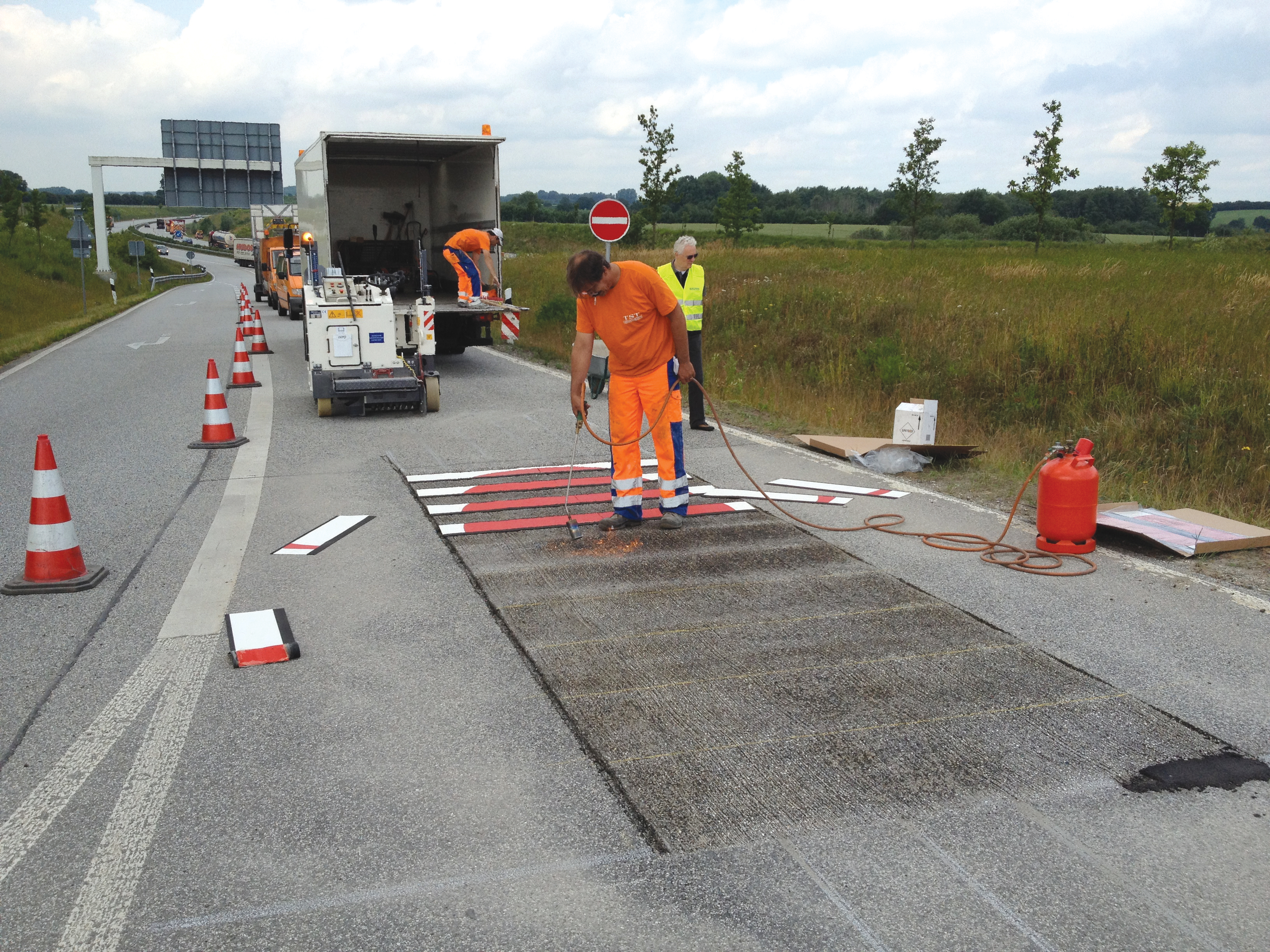
The latest road marking systems have been used to reduce potentially fatal wrong-way driving and promote the recent EURO 2012 football tournament in Poland and Ukraine. Guy Woodford reports
According to statistics quoted by leading road marking firmWrong-way driving is also a significant issue across Europe and other parts of the world. Work to combat the potentially lethal activity took place recently in the state of Schleswig-Holstein, northern Germany.
At the Gross Grönau exit ramp on the A20 in Lübeck, six wrong-way drivers were reported to the authorities in 2011 despite message signage at that location, including ‘No Entry’ signs 25m down the exit ramp.
As a result, the road authorities in Schleswig-Holstein have decided to have a Geveko PREMARK 3D-X ‘No Entry’ sign installed at the exit ramp to warn drivers not to enter the exit the wrong way.
PREMARK 3D-X is said by Geveko to be a new patent-pending road marking concept, where 60cm-60cm PREMARK 3D-X road signs milled by a bespoke milling machine from German road marking company TST are combined with PREMARK preformed thermoplastic road marking. Special sinus shaped grooves in the thermoplastic road marking make the road signs visible in one direction only.
As well as providing a safety system for highway exits, PREMARK 3D-X is also said to help solve problems with accident black spots, in local communities, such as near schools. It can also increase safety at dangerous T-intersections without sufficient lights and road safety markings.
In Denmark, PREMARK 3D-X road signs carrying the word ‘STOP’ have been placed by 10 highway exit ramps in a trial that began in autumn 2010. Danish road authorities have, according to Geveko, said that the markings have performed well.
PREMARK 3D-X is a raised road marking with 3D features, which Geveko claims allows higher visibility. The optional multi coloured horizontal sign has the same recognition as a vertical sign, but it is placed in the centre of the driver’s attention fields. The road marking solution is also said to be snow plough resistant.
In June 2012, in accordance with its strategy to concentrate the company to its core business and enhance liquidity, Geveko sold 20% of its shares in its jointly-owned Hungarian subsidiary Magyar Plastiroute Kft.
Magyar Plastiroute provides contract road-marking services and winter road maintenance on motorways and the public highways in Hungary. The business also includes products within the traffic engineering segment.
The Geveko shares are said to have been acquired by a private Hungarian company. The purchase price amounted to US$1.4million (SKR 10million).
With the sale of the shares in Magyar Plastiroute and other liquidity improvement measures in combination with seasonal loans from major banks, Geveko said the need of seasonal liquidity was now satisfied.
After the sale of shares, Geveko’s shareholding in Magyar Plastiroute is now 44%. Magyar Plastiroute will thus be accounted for as an associate company which will result in Group accounting loss of approximately SKr 10 million.
Meanwhile, Geveko has switched its road marking materials production from Gothenburg to its Kristianstad, Sweden-based subsidiary Cleanosol AB.
Remaining in Europe, three
Operated by one person from a
The RMT system is said to be made for use in slow moving traffic as well as in fast traffic, so as to not interrupt normal traffic flow.
A 1,500kW converter powers the RMT, which has a backup system based on two batteries that give three hours of stand still supply.
The RMT’s innovative mobile measurement of data, in one single run, is said to enable the crucial calculation of a road marking’s dry and wet retrorefleciton at night; its luminance coefficient; its skid resistance value; and its width, length, gap and thickness.
The luminance coefficient describes the amount of light that the road marking reflects back to the driver on a cloudy day, when daylight is the only light source.
The skid resistance test is a simulation of the friction that a patterned car tyre receives when you lock the brakes at 50km/h on a wet road marking. This is said by Römboll to be especially important for two wheel vehicles and pedestrians.
Measuring the width, length, gap and thickness of a road marking is said to enable clients to make sure that contractors or sub contractors have met their working brief.
Following an RMT application, parameter calculation data is collected and sent to the office for post processing. Results can be gathered in a database for easier access through a bespoke data viewer. The Ramböll designed RST viewer displays all analysed survey data together with location, distance and/or GPS position, front view images and location on a map.
The Digimark surface graphics imaging system from
Polish contractor Termo was appointed to apply over 100 of the specially-designed Digimark graphics to roads and pavements across the city, which hosted Group A games during the June tournament. The markings were said by Ennis Prismo to provide a simple, yet eye-catching display.
Digimark is a self-adhesive, digitally-imaged display sheet, designed for temporary or permanent placement on hard surface areas. It is said to enable full colour graphics to be applied to practically all vehicular and pedestrian ground surfaces. Since virtually any high resolution graphic or image can be reproduced, Digimark is suitable for a wide range of applications from advertising and decoration, to playground markings and floor plans or maps.
The Digimark system is said to be incredibly easy to use and provides an instant, high quality, visually-impacting area. It can be applied or removed in minutes on any area that is dry, free from debris and in good repair. Contractors simply prime the application area with a suitable primer, remove the backing tape from the product, then layout the graphic and apply pressure to adhere. Removal is said to be achieved by simply warming the product with a gas torch or steam hose. The image can then be lifted, leaving no residue on the road surface.
Digimark features a polyurethane top coat which is fully transparent and highly durable, while being said to resist degradation and deterioration when exposed to ambient weather conditions. According to Ennis Prismo, the resultant protective finish does not reduce the visual quality of the image beneath. A recycled glass cullet, containing anti-slip particles, is said to ensure a safe, skid and slip-resistant finish.
Bonding to the road surface via a natural bitumen, Digimark is said to have excellent adhesive qualities. Included in the construction is a high strength fabric layer on to which the ink graphic is printed. This reinforced fibre is said to control the flexural rigidity and the extent of bond strength development to ensure ease of removal at the end of use.
Together with its Turkish distributor Yol Makina, Borum won a tender for four airport marking machines to serve different airports around Turkey. Each machine will serve several airports and will be transported from one airport to the other, said to create high expectation for robust machine design and reliability.
The construction of the machines was based on the Borum Master 3000. Their extended chassis’ contain two material tanks: one 1000 L and one 500 L stainless steel paint tank. Each paint tank is equipped with low level alarm to avoid sudden stops in the line-marking process.
To ensure efficient working, the Borum machines are each equipped with two airless pumps making it possible to perform markings with two different colours at the same time. With this set-up and with five paint guns on a wide retainer, Borum claim it is possible to make perfect lines of 100-150cm width.
On the Turkey-airport tender machines, the paint consumption is monitored via a sensor mounted on each pump. The Borum LineMaster computer allows the line thickness to be displayed and stored in the work log file which can be handed directly over to the administrative office for generating reports. The LineMaster also calculates the total length of a marking for use in the marking report and additional information, such as the air and road surface temperature and the humidity, can be added to the final document.
The language of the LineMaster is set to Turkish language for the airport applied machines. In LineMaster it is possible to store up to 99 different line types and arrange these in up to 30 different marking programs, making it easy for the operator to handle all the specific markings used in airports.
The official Turkish airport contract was signed by Borum in September 2011 the machines were delivered to Turkey in spring 2012. The process of training the operators is said by Borum to be underway.
Norwegian traffic marking specialist Trysil Maskin has designed the Trafficprinter, said to be a safe new system for applying signs and symbols on roads.
The machine can apply all Nordic road marking symbols from its computer library, while users can also program in any other type of sign required.
Safe operation is claimed compared with manual methods, as the truck is equipped with a TMA at the rear. The operator sets the system to apply the markings, which are then dusted with glass beads for wet weather reflectivity.
The driver can stop the truck during printing if required and the vehicle will halt when it comes to the end of the programmed task.
The print is made of drops of thermoplastic, so the symbol can either be made with droplets floating together to make a full covering surface, or made with space between the droplets to deliver better wet retro-reflectivity.
The machine can print markings up to 2.2m wide and as long as required. But if wider symbols are needed they can be printed in multiple operations.
The Trafficprinter is based on a Man TGX 6x2 truck chassis powered by an engine delivering 358kW and features a 1,200litre paint tank for preheating that is diesel fired.
A 450litre glass bead tank is fitted, with delivery provided by an onboard compressor.
Cold-spray plastic fantastic
In the study, different ecological impact parameters were evaluated for each marking system, including the global warming potential, photochemical ozone creation potential, and eco-toxicity influences relating to humans, freshwater and soil organisms.
The system appraisal was said to be based on typical product formulations in comparative application scenarios and empirical data. Core data, such as consumption of marking material and glass beads, for example, was said to be taken from approval test certificates of the corresponding road marking systems issued by the German Federal Highway Research Institute (BASt) and empirical data.
Evonik said that, according to the research, solvent-borne or water borne systems proved in practice to be far less durable than cold-spray plastics, resulting in significantly higher overall material consumption. For example, a solvent-borne paint needs to be reapplied together with corresponding amounts of broadcasted glass beads ten times to attain minimum requirements for ten years, while cold-spray plastic needs to be applied only four times. This is said to allow a much more efficient use of the marking material and thus provides less impact on the environment. Thermo-spray plastics were also said to have been found durable, but their long useful life is attained at the cost of high material consumption per application.
On toxicological environmental impact, no disadvantages were said to have been found for marking with cold-spray plastic when compared to thermo-spray plastic or water-borne paint. Cold-spray plastic is said to have emerged as an attractive material option to avoid volatile organic compound (VOC) emission, reducing photochemical ozone creation at the ground level. Summing up the research conclusions, Dr Alexander Klein, technical marketing director at Evonik, said: “Due to their durability, cold plastic and thermoplastic systems turn out to be resource-efficient, environmentally friendly road marking solutions at higher traffic loads, while short-lived paint systems are good options for roads with low traffic density.”

